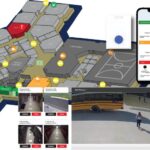Last year, organizations from all industries had to face their most significant challenge yet, brought on by the COVID-19 pandemic. Higher education organizations in particular were forced to adapt rapidly, as more than 4,000 colleges and universities had to end the school year early or shift to remote learning.
In October 2020, 44% of nearly 3,000 campuses were remote-only or primarily remote, while less than 27% reopened with primarily in-person or only in-person learning, reports The Chronicle of Higher Education. With these figures, it’s not surprising that the higher education industry – like other industries – has been experiencing financial challenges, as it struggles with enrollment and remote learning. This only enforces the need to prioritize safety technologies on campuses to ensure students feel comfortable getting back on campus.
Before the pandemic, campuses’ biggest safety concern was finding ways to keep their community and students protected from crime on campus and surrounding neighborhoods. But COVID-19 brought on new threats and challenges, forcing higher education officials to rethink protective strategies, including finding new safety tech to implement across their campuses. Pre-COVID-19, key safety tools included detailed record management systems (RMS) to help campus law enforcement determine “hot spots” for crimes in the area, computer aided dispatch (CAD) systems to help campus police respond to emergency calls quickly, and campus apps alerting students of local criminal incidents and allowing students to easily report and alert campus police of crime.
With the new threats presented by COVID-19, there has been an evolution to more robust and high-tech campus solutions, including:
- Temperature Screening Devices – Using infrared technology, these devices are designed to determine when an individual is experiencing symptoms, such as fever. This technology will likely become more widely adopted on college campuses, as it will be able to scan multiple students at a time while entering classroom and administration buildings or dorms.
- Additional Health Screening Devices – This consists of stationary tablets with quick health-related questionnaires and health screening apps for students, faculty and staff to report potential symptoms before heading onto campus, or whether they have or have not been vaccinated.
- Visitor Management Software and Apps – A helpful tool for tracking dorm visitations, this helps track how many people are in a building at one time and logs who was at a certain location during a specific time. This also provides campus police and officials with reports or audits of where students are more likely to congregate.
- Sanitation Technology – From sanitation compliance apps and software that help track the cleanliness of classrooms, offices, dorms and other facilities, to UV-light tools that help disinfect everyday appliances and shared devices, these are tools we can anticipate seeing across various campus buildings.
Even though there has been a surge of innovative safety technology solutions to aid in the safe reopening of colleges, campuses are experiencing significant budget cuts and are not able to implement them all. According to the American Council of Education (ACE), the financial impact of the current pandemic is expected to exceed $120 billion, much of it due to low enrollment and tuition dollars. However, this only enforces the need for higher ed officials to adopt COVID-safety technology that helps ensure a safe return to schools for students, staff and faculty.
As college campuses across the nation felt the immediate impact of the COVID-19 pandemic, forcing shutdowns and moving almost-exclusively to remote learning, the higher education industry has been forced to rethink campus safety strategies, including the implementation of new coronavirus-specific solutions. And, although the financial challenges brought on by the pandemic have made it difficult to determine which tech innovations to implement on campus, the need for these solutions is eminent in the safe reopening of campus, not only to protect against the threat of COVID-19 but future threats, as well.
Richard DeFranciso is Omnigo Software’s CEO.













